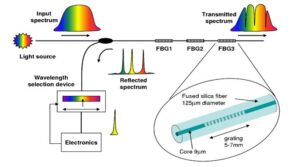What is Photonics-based sensing?
Why is Compass Photonics such a fan of photonics-based sensing? It is the power and elegance of measuring with light!
Photonics is the physical science of light waves. It deals with the science behind the generation, detection and manipulation of light.
Photonics underpins technologies of daily life from smartphones to laptops to the Internet to medical instruments to lighting and of course sensing technology. We deploy this technology to develop technology for the acquisition, analysis, and implementation of large quantities of accurate and reliable data. Essential for optimization of your business. We facilitate data harvesting, bridging the gap between the physical world, and reliable data.
What can it do?
Using only light and fibers there are some specific characteristics to Photonics-based sensing:
Operable in Harsh environments and intrinsically safe
- ATEX zones
- Extreme temperatures
- Radiation
- HV fields
- Liquids / moisture
- No fire hazard due to lightning
Optical signal
- No power at sensing location
- Immune to EM interferences
- Easy to reach remote locations
Design freedom
- Lightweight
- Flexible
- Small dimensions
History of Photonics
The word ‘photonics’ is derived from the Greek word “photos” meaning light; it appeared in the late 1960’s to describe a research field whose goal was to use light to perform functions, that traditionally fell within the typical domain of electronics, such as telecommunications, information processing, etc.
Photonics as a field began with the invention of the laser in 1960. Other developments followed: the laser diode in the 1970s, optical fibers for transmitting information, and the erbium-doped fiber amplifier. These inventions formed the basis for the telecommunications revolution of the late 20th century and provided the infrastructure for the Internet.
Though coined earlier, the term photonics came into common use in the 1980s as fiber-optic data transmission was adopted by telecommunications network operators. At that time, the term was used widely at Bell Laboratories. Its use was confirmed when the IEEE Lasers and Electro-Optics Society established an archival journal named Photonics Technology Letters at the end of the 1980s.
During the period leading up to the dot-com crash circa 2001, photonics as a field focused largely on optical telecommunications. However, photonics covers a huge range of science and technology applications, including laser manufacturing, biological and chemical sensing, medical diagnostics and therapy, display technology, and optical computing. Further growth of photonics is likely if current silicon photonics developments are successful.
Relationship to other fields
Classic optics
Photonics is closely related to optics. Classical optics long preceded the discovery that light is quantized, when Albert Einstein famously explained the photoelectric effect in 1905. Optics tools include the refracting lens, the reflecting mirror, and various optical components and instruments developed throughout the 15th to 19th centuries. Key tenets of classical optics, such as Huygens Principle, developed in the 17th century, Maxwell’s Equations and the wave equations, developed in the 19th, do not depend on quantum properties of light.
Modern optics
Photonics is related to quantum optics, optomechanics, electro-optics, optoelectronics and quantum electronics. However, each area has slightly different connotations by scientific and government communities and in the marketplace. Quantum optics often connotes fundamental research, whereas photonics is used to connote applied research and development.
The term photonics more specifically cannotes:
- The particle properties of light;
- The potential of creating signal processing device technologies using photons;
- The practical application of optics; and
- An analogy to electronics.
The term optoelectronics connotes devices or circuits that comprise both electrical and optical functions, i.e., a thin-film semiconductor device. The term electro-optics came into earlier use and specifically encompasses nonlinear electrical-optical interactions applied, e.g., as bulk crystal modulators such as the Pockels cell, but also includes advanced imaging sensors typically used for surveillance by civilian or government organizations.
Emerging fields
Photonics also relates to the emerging science of quantum information and quantum optics, in those cases where it employs photonic methods. Other emerging fields include optomechanics, which involves the study of the interaction between light and mechanical vibrations of mesoscopic or macroscopic objects; opto-atomics, in which devices integrate both photonic and atomic devices for applications such as precision timekeeping, navigation, and metrology; polaritonics, which differs from photonics in that the fundamental information carrier is a polariton, which is a mixture of photons and phonons, and operates in the range of frequencies from 300 gigahertz to approximately 10 terahertz.
Fiber bragg grating
Of all the possibilities with Photonics-based sensing we believe the queen of them all is the Fiber Bragg Grating, specifically draw tower gatings. With this technology the fiber becomes the sensor. The grating, burned in the fiber while drawing it out of the glass core bofre the cladding is added, is like a barcode inside the fiber. On every bragg location a typical reflection of light is created. When the fiber is manipulated (strain +/-, temperature) the typical reflection changes and produces a peak shift. Because the original waivelength is known, the induced manipulation can be explained hence provides data.
